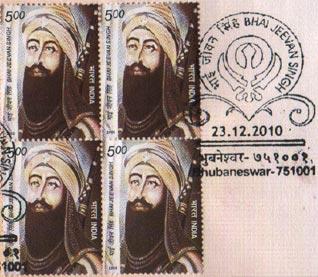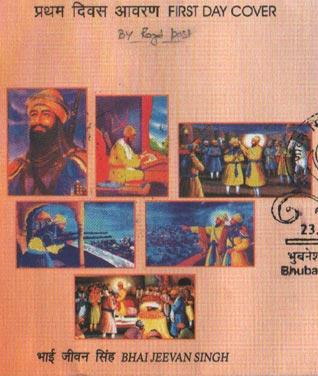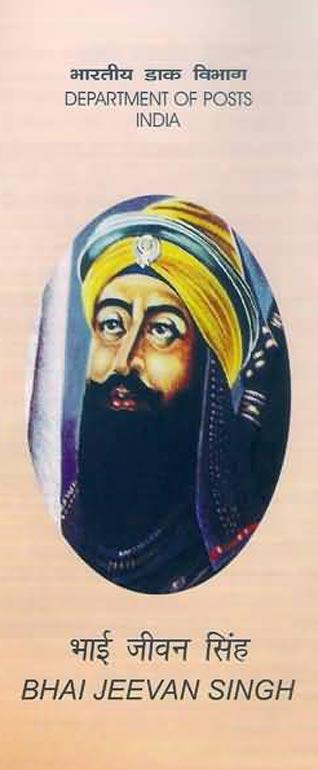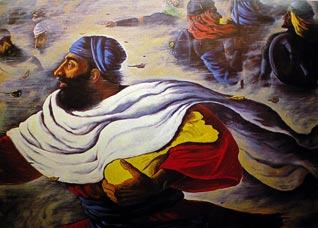Our Heroes
New Stamp Honours A Hero: Bhai Jeevan Singh
NEWS REPORT - Bio by A.C. BANNERJEE
A new postage stamp, released by India on December 23, 2010, honours the memory of an extraordinary 17th/18th century hero and martyr.
BHĀĪ JĪVAN SIṄGH (1649-1705) - BhÄÄ« JaitÄ before he had received the rites of initiation at the hands of GurÅ« Gobind Siá¹…gh in 1699 - was a Sikh belonging to the scavenger community who was given by GurÅ« Gobind Siá¹…gh the epithet of 'Raá¹…ghreá¹Ä, GurÅ« KÄ Beá¹Ä' (proclaiming the young man as the GurÅ«'s own son) when he brought the severed head of GurÅ« Tegh BahÄdar from Delhi where the latter was executed under the orders of the emperor.
BhÄÄ« JaitÄ was born on 30 November 1649 to mother Karmo and father SadÄ Chand. At the time of his birth, he was named JÄg Chand, shortened to JÄgÅ« or JotÄ. He and his younger brother, BhÄg Chand, also called BhÄgÅ«, were the disciples of GurÅ« Har RÄi, NÄnak VII.
From KÄ«ratpur, in the ÅšivÄlik hills, where the GurÅ« then resided, they moved, along with their parents, to the village of Jhaṇá¸Ä RÄmdÄs where they stayed with BhÄÄ« GurdittÄ (1625-1675), the great-great-grandson of BhÄÄ« Buá¸á¸hÄ.
As BhÄÄ« GurdittÄ was detained in Delhi following the arrest of GurÅ« Tegh BahÄdar, JaitÄ was sent by the family to bring news of him. He was in Delhi when GurÅ« Tegh BahÄdar was beheaded in a public thoroughfare (11 November 1675), and as no one came forward to claim the bodily remains for fear of reprisals, he succeeded in evading the guards and escaping with the severed head to Anandpur where he was received with much honour by GurÅ« Gobind Siá¹…gh.
He thereafter lived at Anandpur, becoming the first nagÄrchÄ« or beater of the drum when the GurÅ« set up the RaṇjÄ«t NagÄrÄ.
In 1691, he was married to RÄj Kaur, daughter of SujÄn Siá¹…gh of the village of RiÄá¹›, near Amritsar, and they had four sons.
He received the rites of initiation when GurÅ« Gobind Siá¹…gh inaugurated the KhÄlsÄ on 30 March 1699.
JaitÄ was then renamed JÄ«van Siá¹…gh.
He became famous as a marksman and trained the two elder sons of Gurū Gobind Siṅgh in the art of warfare. He himself took part in all of Gurū Gobind Siṅgh's battles against the hill chiefs and the Mughals.
BhÄÄ« JÄ«van Siá¹…gh fell a martyr in the battle of Chamkaur on 7 December 1705. A burj or a tower stands on the site as a monument to his memory.
[Bio of Bhai Jeevan Singh, courtesy - The Encyclopaedia of Sikhism, Edited by Harbans Singh]
January 2, 2011
Conversation about this article
1: Ravinder Singh Khalsa (U.S.A.), January 07, 2011, 10:37 AM.
Great to see a stamp brought out in India depicting a Sikh with a turban. The Indian government should also pursue an international effort to bring respect to the turban internationally, especially in France, USA, etc. Sikhs are an honorable people, unfortunately we are misunderstood and often misunderstand ourselves what Sikhism represents ...






